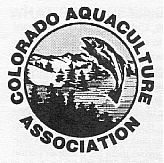About Us
Colorado's Aquaculture Heritage
Colorado has a rich history of aquaculture development and production. Some of the first fish production facilities in the country were established in this state. Unlike other states located in the southern tier and coastal areas of the U.S., Colorado does not have a reputation as a major producer of aquacultured products. A semi-arid, continental-temperate climate, resulting in a relative scarcity of water, and a land-locked border discourage widespread use of "traditional" forms of aquaculture that require large amounts of flowing or standing water and year-round, sub-tropical temperatures.
For many decades, however, cool natural springs located in and near the mountainous areas of the state have been used for the production of several coldwater trout species; most notably, rainbow trout for the recreational and foodfish markets. More recently, producers have begun augmenting natural flow by pumping water from these underground supplies.
By far, in terms of sales, rainbow trout is the state's highest-value aquacultured commodity. During recent years, Colorado ranked fifth among all states with total trout sales of about $2.3 million. Despite the seemingly high ranking, Colorado's contribution to total national trout sales of about $87.5 million was relatively small, with Idaho producing nearly 53 percent of the national output of trout as measured by sales.
As a result of the relative limitations imposed on traditional aquaculture by the state's natural resources and climate, some individuals and companies have resorted to more innovative approaches and technologies for producing warmwater aquatic organisms. Additionally, they have begun to take advantage of man-made resources and some natural resources that are unique to Colorado. Endowed with abundant sunshine and significant geothermal resources, some producers are turning to indoor, high-density production in water recirculation tank systems as a means to conserve water, to economically heat water for the production of warmwater fishes, and to retain these valuable resources within the production system. When these indoor fish production techniques are coupled with the production of plants (an integrated approach called aquaponics), production and conservation of resources are enhanced even more.
These new approaches and technologies have fueled a significant expansion in the number of species that have been, or are currently, produced within Colorado. In addition to trout, the list includes salmon, catfish, tilapia, hybrid striped bass, largemouth bass, muskellunge, sunfishes, yellow perch, walleye, grass carp, ornamental (aquarium) species, freshwater shrimp, alligator, and others.
Complementing the interest in the private sector in new aquaculture opportunities, Colorado state government restructured its jurisdiction over aquaculture activities. Fish production has now been formally recognized as an agricultural pursuit and is entitled to the same kinds of benefits and incentives as other agricultural activities. Lobbying efforts funded by the Colorado Aquaculture Association, a state-wide organization of aquaculture interests, were instrumental in the passage of legislation to implement this crucial change in government oversight and improve the regulatory climate for aquaculture in the state.
The Association
The Colorado Aquaculture Association was formed to provide a credible and unified voice for its membership and advance their collective views. Active in state and federal legislative matters, the Association addresses issues that impact the aquaculture industry and actively fosters goodwill toward aquaculture producers and other supporting enterprises.
The Association annual meeting is held at varying locations around the state (but almost always at Mt. Princeton Hot Springs Resort in Nathrop, Colorado), during January or February. Stay abreast of details for our next meeting by contacting us directly or visiting our News
page. Plan to attend!
Copyright © 1999-2024 Colorado Aquaculture Association. All rights reserved. Do not copy or reproduce without permission.

